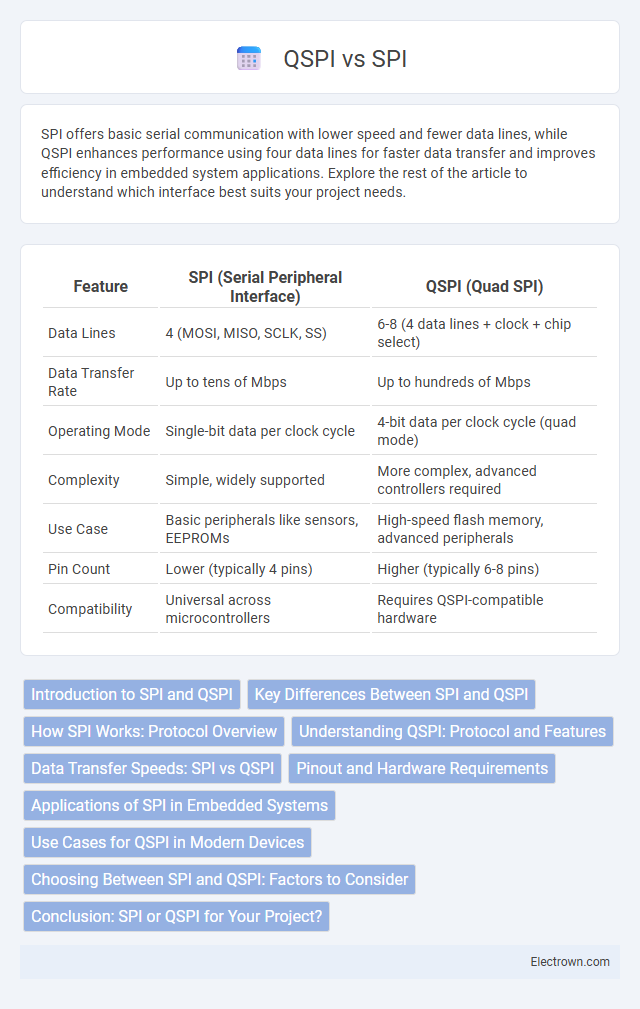SPI offers basic serial communication with lower speed and fewer data lines, while QSPI enhances performance using four data lines for faster data transfer and improves efficiency in embedded system applications. Explore the rest of the article to understand which interface best suits your project needs.
Table of Comparison
| Feature | SPI (Serial Peripheral Interface) | QSPI (Quad SPI) |
|---|---|---|
| Data Lines | 4 (MOSI, MISO, SCLK, SS) | 6-8 (4 data lines + clock + chip select) |
| Data Transfer Rate | Up to tens of Mbps | Up to hundreds of Mbps |
| Operating Mode | Single-bit data per clock cycle | 4-bit data per clock cycle (quad mode) |
| Complexity | Simple, widely supported | More complex, advanced controllers required |
| Use Case | Basic peripherals like sensors, EEPROMs | High-speed flash memory, advanced peripherals |
| Pin Count | Lower (typically 4 pins) | Higher (typically 6-8 pins) |
| Compatibility | Universal across microcontrollers | Requires QSPI-compatible hardware |
Introduction to SPI and QSPI
SPI (Serial Peripheral Interface) is a synchronous serial communication protocol used for short-distance communication between microcontrollers and peripheral devices, offering simplicity and speed. QSPI (Quad SPI) enhances standard SPI by transferring data over four lines simultaneously, significantly increasing data throughput and efficiency in memory access. Your choice between SPI and QSPI depends on the need for faster data rates and higher performance in embedded systems.
Key Differences Between SPI and QSPI
SPI (Serial Peripheral Interface) transfers data one bit per clock cycle using four main signals: MOSI, MISO, SCLK, and SS, while QSPI (Quad SPI) enhances this by using four data lines for simultaneous four-bit data transfer, significantly increasing speed. The key difference lies in QSPI's ability to achieve higher throughput and faster read/write operations compared to standard SPI, making it ideal for memory devices requiring quick access. Your choice between SPI and QSPI depends on the need for speed and data bandwidth in embedded systems or flash memory applications.
How SPI Works: Protocol Overview
SPI (Serial Peripheral Interface) operates using a master-slave architecture with four main signals: MOSI (Master Out Slave In), MISO (Master In Slave Out), SCLK (Serial Clock), and SS (Slave Select). Data transfers occur synchronously, with the master generating the clock signal while both master and slave exchange data bits simultaneously on the MOSI and MISO lines. QSPI (Quad SPI) enhances SPI by using four data lines for high-speed data transmission, effectively quadrupling the data throughput compared to standard SPI.
Understanding QSPI: Protocol and Features
QSPI (Quad Serial Peripheral Interface) enhances the standard SPI protocol by utilizing four data lines for simultaneous data transfer, significantly increasing throughput compared to the single data line used in SPI. The QSPI protocol supports higher clock speeds and mode configurations, enabling faster and more efficient communication with flash memory devices in embedded systems. Key features of QSPI include dual/quad I/O modes, command instruction support, and extended addressing, making it ideal for applications requiring rapid data access and high bandwidth.
Data Transfer Speeds: SPI vs QSPI
QSPI offers significantly higher data transfer speeds compared to standard SPI by utilizing four data lines instead of one, enabling simultaneous transmission of four bits per clock cycle. This parallel data processing greatly accelerates read and write operations, making QSPI ideal for high-performance memory applications and faster system boot times. SPI typically transfers data at rates up to tens of megabits per second, while QSPI can achieve several hundred megabits per second, enhancing overall communication efficiency.
Pinout and Hardware Requirements
SPI (Serial Peripheral Interface) typically uses four pins--MOSI, MISO, SCLK, and SS--offering a simple hardware setup suitable for basic communication with peripheral devices. QSPI (Quad SPI) expands on this by adding four data lines, enabling faster data transfer rates while requiring additional pins and more complex hardware support. Your choice of SPI or QSPI will impact the pinout complexity and hardware resources needed for your embedded system design.
Applications of SPI in Embedded Systems
SPI (Serial Peripheral Interface) is widely used in embedded systems for interfacing microcontrollers with peripherals like sensors, memory devices, and displays due to its simplicity and fast synchronous communication. Common applications include EEPROM and flash memory access, real-time clock communication, and sensor data acquisition, where precise timing and low-latency data transfer are critical. QSPI (Quad SPI) enhances these applications by offering higher throughput and faster memory read speeds, ideal for advanced embedded systems requiring rapid code execution and large data handling.
Use Cases for QSPI in Modern Devices
QSPI (Quad SPI) is extensively used in modern devices requiring high-speed data transfer and rapid access to large memory, such as in embedded systems, smartphones, and IoT devices. Its four data lines offer significantly faster read/write speeds compared to traditional SPI, making it ideal for executing code directly from external flash memory (XIP) and supporting firmware updates. QSPI's enhanced performance enables efficient boot times and seamless multimedia streaming in consumer electronics and automotive applications.
Choosing Between SPI and QSPI: Factors to Consider
Choosing between SPI (Serial Peripheral Interface) and QSPI (Quad SPI) depends primarily on required data transfer speed and system complexity. SPI offers simplicity and broad compatibility with standard 1-bit data lines, while QSPI significantly increases throughput using four data lines, ideal for high-performance memory applications. Consider power consumption, pin availability, and software support to determine the best fit for embedded systems or flash memory interfaces.
Conclusion: SPI or QSPI for Your Project?
SPI offers simplicity and cost-effectiveness for basic communication and lower-speed applications, making it ideal for projects with minimal data transfer requirements. QSPI provides higher data throughput and enhanced performance by utilizing multiple data lines, suited for advanced applications like high-speed memory access or embedded systems demanding rapid data exchange. Choosing between SPI and QSPI depends on specific project needs regarding speed, complexity, and budget constraints.
SPI vs QSPI Infographic

 electrown.com
electrown.com